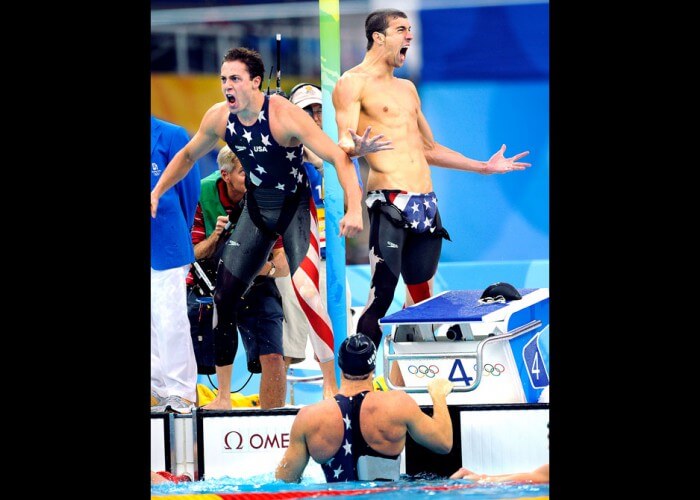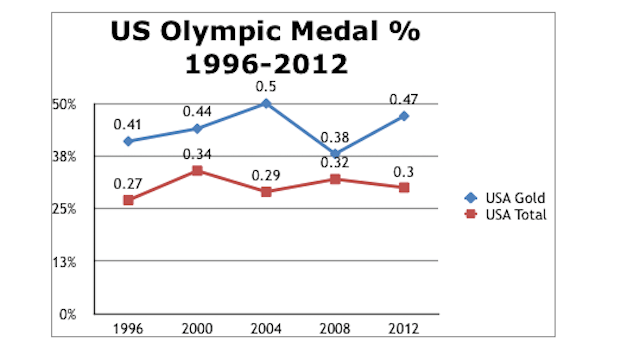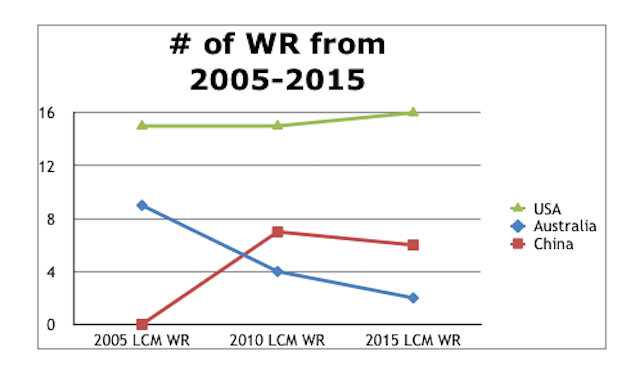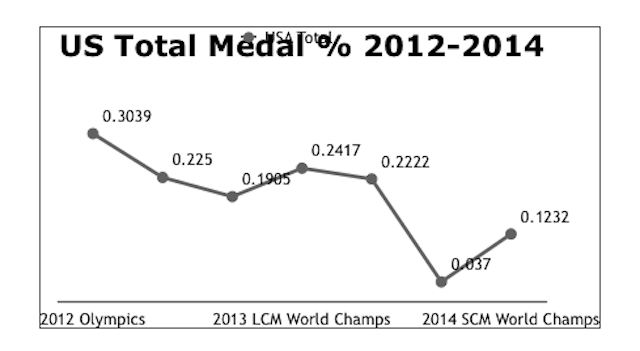Is The Olympic Future of USA Swimming in Trouble?

By Eric Bugby, Swimming World Contributor
“Numbers never lie.” It’s a sports idiom. Like all sayings, they become overused, cliché, and eventually “miss the mark.” But this one “goes the distance.” Sorry. But numbers are important enough for ESPN to create a show outlining how they can shape the future.
In swimming, the clock tells all. The scoreboard turns lambs into lions (or goats) and can even unite countries. There’s another number that may reveal a deeper truth, medal count.
Medal count can be perceived in two ways: (a) the overall depth of a team or country and (b) if you have Michael Phelps on your team.
What do these numbers tell us? Can they predict future trends?
Olympic Medals
Chart 1 is the medal percentage, gold and total, of the United States (US) at the Olympic Games from 1996 to 2012.
The US has consistently been the top dog at the most prestigious meet in the world. The US rose quickly from 1996 to 2004, where they took home half the gold medals in Athens. That number fell to 38 percent in 2008, which was fairly close to their total medal haul. Thank you, Michael.
2012 saw a jump back to nearly half of the gold medals. Thank you, Missy. But there was also a decrease in total medals.
Is it a better for the US to have a higher gold percentage or higher total percentage? Gold percentage tells us we have the best of the best. It’s great for TV ratings and marketability of athletes. Total percentage shows a team’s overall depth, and possibly, their future.
Looking at the chart, 2008 was a down year. Yes, the 2008 Olympics in Beijing were a down year for the US. You won’t hear anyone say that due to Phelp’s record and the greatest swimming race in history. Thank you, Jason.

Photo Courtesy: Wally Skalij
World Records
Chart 2 is the total number of long course world records (WR) that the US, Australia, and China held at the end of 2005 and 2010 and the current number of WR each country currently holds.
The total WR count shows something unique: the number of elite athletes from each country over the past ten years. Not depth and not what the future holds.
What the numbers also do not show is how many unique athletes are represented each year. It’s easy to assess that the US has not peaked, but is only getting better. Upon closer look, Michael Phelps currently holds 6 and Katie Ledecky holds 3. That’s two athletes with over 50 percent of the total. China’s 6 are held by 5 athletes.
Australia is a world swimming power, there is no debate, but there is a downward trend since 2005. The numbers show either (a) the number of elite athletes in Australia is declining or (b) the world is catching up. James Magnussen and the Campbell sisters would say otherwise to the former. Unfortunately, the days of Stephanie Rice, Ian Thorpe, Grant Hackett, and Leisel Jones are long gone. Is this the future of the US?
What’s Next?
Chart 3 is the total medal percentage of the US from 2012 to 2014 at all international competitions.
Ouch. That’s the first word that comes to mind looking at this chart.
Total medal count shows overall depth. The US was strong at the 2012 Olympics, winning the medal count, and maintaining their 30 percent average since 1996. The US clearly hasn’t peaked in this regard.
But is the US in a bear market? At the most important meet in 2013, the US only claimed 24 percent of the total medals. That number dipped to 12 percent at the 2014 Short Course Worlds.
There are a number of reasons why this trend is occurring: focus is the Olympics, swimmers are in college, injuries, no Michael Phelps, etc. It doesn’t explain why the depth of the US isn’t represented. Even if the best American athletes aren’t attending these meets, then why aren’t other Americans on the podium? It’s a question that needs to be asked to a country that places these meets on their quad plan.
The youth trend is also disturbing. The US went home with 4 percent of the total medals at the 2014 Summer Youth Olympics. Clearly, other countries are placing a focus on their youth, developing talent, and taking the best to these meets. It is paying off. That experience is second to none.
How are they doing it? Is it philosophy, training, technique, money, or something that we haven’t asked yet?
Where are the next stars? When will the next crop of elite athletes from the US rise? Will China, Australia, Great Britain, Japan, Brazil, France, or someone else get their hand on the wall first? This summer will showcase the world’s talent and where the US truly stands after a poor 2013 and 2014.
Sheer numbers will not cut it against a world swimming community that loves to compete, improve, and take their shots at the US.







R u kidding me!?
Yes
The rest of the world is catching up to or in some cases has caught/surpassed us in certain areas (men’s/women’s sprints, men’s distance) anf I submit one of the main reasons is American college coaches’ penchant for recruiting foreign swimmers. Every Cesar Cielo/Arianna Vanderpool-Wallace who gets a fullride to Auburn, for example, or every Joseph Schooling @. Texas is one less American on a D1 team.
Yes, I know,many national federations help w/costs. But in a nation of 350 million people — where the number of competitive swimmers in California, Texas and Florida alone outnumbers almost any other nation on earth — you mean to tell me there ain’t enough good domestic athletes to fill our college teams?
Baloney.
American college coaches should recruit American athletes, first and foremost.
Look @. Cal’s women’s team for example. There are girls from Spain, Canada, Hong Kong, Egypt (!!!) and God knows where else. Bet there are any number of talented young women swimmers in Northern California alone who’d give an arm and a leg to just walk on @. Berkeley if given the opportunity.
Let’s give our best and brightest the opportunity of making it big at home and not relegate them to second-class status. It’s one thing if say a Julia Efimova or a Nikita Lobintsev wants to train as a pro w/Dave Salo @. U They PAY him for his coaching acumen.
It’s quite another to recruit a foreign swimmer and give him/her a fullride because they can score big points for you right away @. NCAAs.
‘Merica for ‘Mericans.
There ought to be a law!
Coaches and programs are not rewarded to recruit patriotically. Their incentives are driven by their ability to produce top flight programs at the elite level. Smaller schools at lower divisions are under pressure to perform not for incentives but simply for the programs to survive given the rash of program cuts – especially men’s programs. The focus on revenue producing sports and the required balancing at all universities is destroying not only men’s swimming but all programs. This contraction has a trickledown effect on the sport in general. Foreign nationals competing in NCAA goes back along time. Patriotism is not the magic bullet….
Agree 100 percent
Is the overly sensational title really necessary?
Shut up. This is a dumb article, fails to look at the fact that many successful Olympians took at least a year off from competition after the Olympics. Also that I’ve never meet anyone that a youth international meet was on the radar and I’ve met the best in the world. Your writing staff needs to take a step back Friday m sensationalism.
Sophie Lauren GUYS! This is our chance
It takes a long time to develop swimmers (or any other type of serious athlete for that matter). How the US does in the future internationally is not so much dependent upon what we have done in international meets the last 10 years. It depends primarily upon how many kids are in organized, more or less year round, swimming programs. If, right now, the US has a lot of kids swimming in the 10 & under, 12 & Under and 14 & under age groups, at decent and well run USS and YMCA teams, then the US is probably going to have a reasonably good international team in the 2020 to 2026 time frame. If not, then our past performance really does not matter.